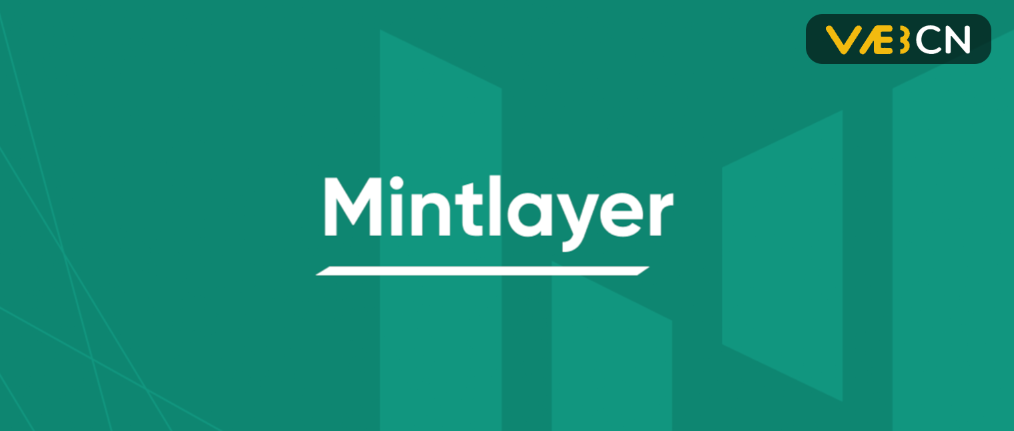
Editor | Callum@Web3CN.Pro
Table of Contents
I. Project Introduction
II. Project Vision
III. Development History
IV. Team Background
V. Financing Information
VI. Project Architecture
- Mintlayer Wallet
- Tokenization Standards
- Decentralized Exchange (DEX)
VII. Development Achievements
- Project Development
- Ecosystem Construction
- Community Status
VIII. Economic Model
- Token Distribution
- Economic Model
IX. Advantages and Risks
I. Project Introduction
Mintlayer is a Layer2 protocol similar to Proof of Stake (PoS), bringing smart contract programmability to the Bitcoin blockchain. It aims to address Bitcoin's scalability issues and improve functionality by enhancing decentralized finance (DeFi) applications, decentralized exchanges (DEX), stablecoins, and tokenization standards on the Bitcoin network. The two main elements that the Mintlayer decentralized protocol brings to the Bitcoin ecosystem are asset tokenization and trading on DEX. It provides a more powerful blockchain environment for DeFi protocols through its scaling solutions: batch transactions and the Lightning Network, reducing transaction size and fees, creating a win-win situation for all parties involved.
Mintlayer can create Bitcoin-driven tokens and smart contracts, inheriting Bitcoin's security and providing interoperability with Bitcoin. This enables DeFi use cases, currently found on Ethereum and other blockchains, to be possible and scalable for the first time in a true Bitcoin native environment (using real Bitcoin without the need for pegging or wrapping). Mintlayer also supports access control lists, which can create compliant tokens and NFTs, support the Lightning Network, transaction batching, and signature aggregation, as well as the first Gas currency free market (where any token issued on Mintlayer can be used to pay transaction fees).
II. Project Vision
As a sidechain of Bitcoin, Mintlayer aims to enable Bitcoin holders to access DeFi, stablecoins, NFTs, and other tokenized assets while fully inheriting the overall security of Bitcoin's proof of work.
As the project's name suggests, it aims to become a new layer for minting various assets: stocks, bonds, stablecoins, asset-backed tokens, and more. However, it is important that these assets are not issued on any random blockchain base network but specifically on the Bitcoin layer. This is the ultimate reason Mintlayer is built on top of Bitcoin, as it envisions forming financial order around the Bitcoin standard.
III. Development History
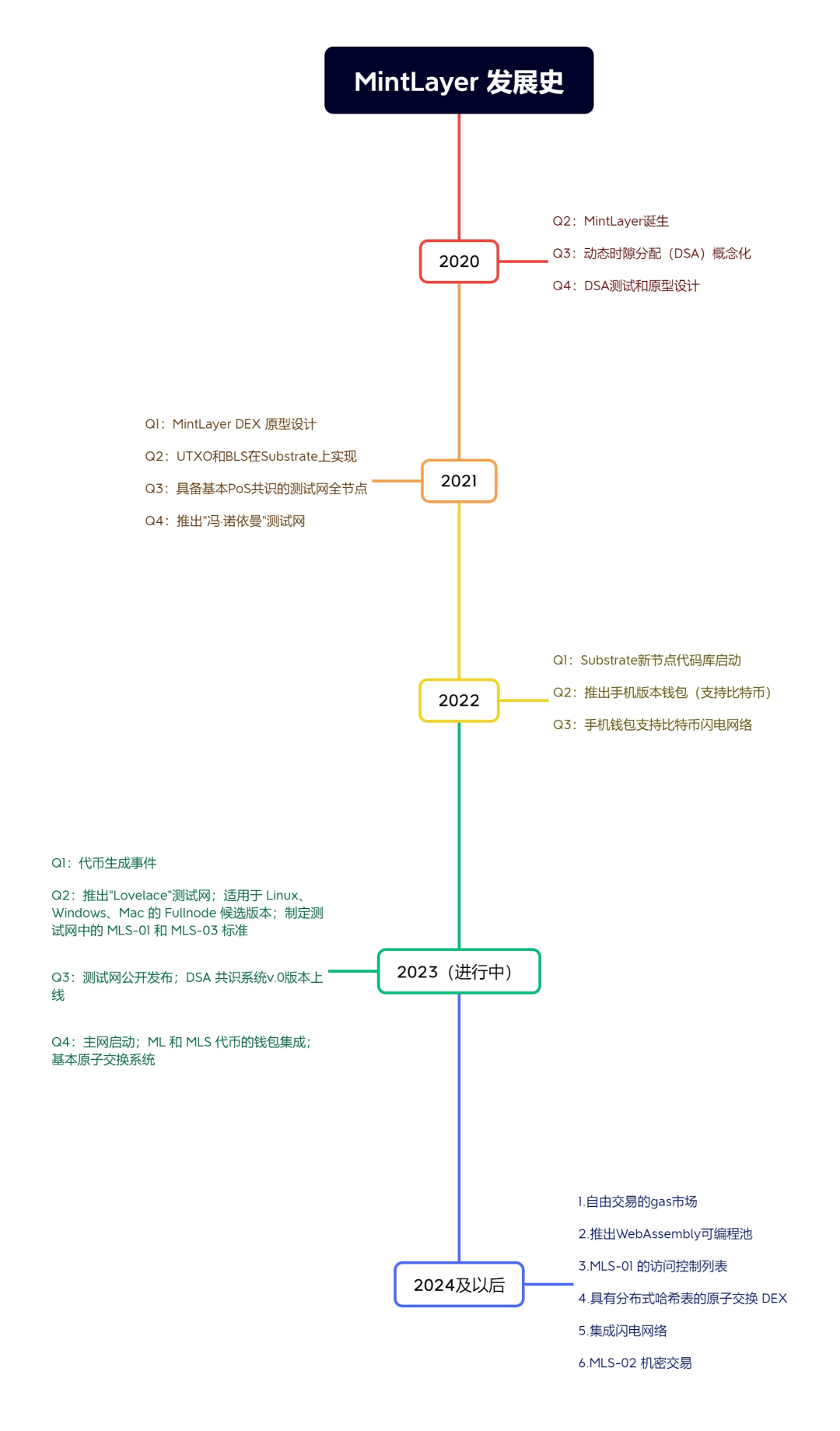
IV. Team Background
The team behind MintLayer is RBB Labs, a software company based in San Marino that provides fintech, financial, and trading solutions, with 16 core contributors. CEO Enrico Rubboli is a software developer with 17 years of experience and a cryptocurrency expert, having previously worked as a developer for Tether and Bitfinex. He is particularly passionate about Bitcoin and interested in new technologies, architecture, and design.

RBB Labs offers blockchain solutions, network security, software engineering, and consulting education to the public, currently leading the development of multiple blockchain projects, including Mintlayer and Stablecomp (a DeFi platform that allows users to easily assess opportunities to earn stablecoin compounding, allocate, and earn interest on multi-chain dApps).
V. Financing Information
On May 24, 2021, Mintlayer raised $5.2 million in seed funding. Investors included Lotus Capital, Moonrock Capital, Jun Capital, EXnetwork, CryptoDormFund, Matrix Ventures, Black Dragon, Sky Ventures, Blockpact, MoonFounde, and other KOLs.
In this round of financing, Alphabit, Moonwhale, 4SV, X21, and Iconomy Partners also joined the project as advisors to Mintlayer. These companies will directly or indirectly leverage their skills, expertise, and extensive networks to help the Mintlayer ecosystem and its user base, as well as provide guidance for the rapid expansion of the project's market. In addition, it has established a strategic partnership with the San Marino Innovation Center.
Furthermore, according to the investment and financing data website Crunchbase, on October 1, 2021, Mintlayer completed a $12 million Series A financing. However, this round of financing has not been verified by the official Mintlayer and no investment institutions have been announced.
VI. Project Architecture
Mintlayer Wallet
The Mintlayer wallet (Mojito Wallet) supports multiple tokens, including Bitcoin (BTC), Mintlayer (ML), and all tokens issued on-chain or pegged (with the MLS token standard), mainly including light wallets and full node wallets.
- Light Wallet
- Stores, sends, and receives Bitcoin like any other traditional Bitcoin wallet
- Stores, sends, and receives ML tokens and all MLS-01, MLS-02, MLS-03 standard tokens
- Batch transactions with other nodes before broadcasting to the network to pay lower fees, reduce the burden on the blockchain, and speed up transaction processing
- Conducts transactions using the Lightning Network (BTC, ML, and MLS-01 standard tokens)
- Conducts peer-to-peer exchanges of BTC, ML, and MLS-01 standard tokens using atomic swap DEX
- Full Node Wallet
The Mintlayer full node is coupled with the Bitcoin Core node. Additionally, the Mintlayer full node uses utreexo, which compresses the size of the UTXO set to 1 KB. Therefore, even in the long run, the processed node will not occupy more than about 3 GB of space (approximately 3 days of blockchain space at maximum throughput).
The Mintlayer full node provides all the functions of the light wallet, as well as the following functions:
- Staking ML tokens to become a "participant" in the network
- As a "participant," proposing or signing blocks and earning transaction fees
- Creating MLS-01 tokens by executing Mintlayer on-chain transactions
- Pegging BTC to create MLS-01/02 tokens for faster transactions and lower fees (also enabling private transactions)
- Creating custom smart contracts and programmable pools, and creating DeFi systems
- Connecting to multiple oracles to query DEX data or identity data, while also facilitating DEX transactions or decentralized identity applications. Providing standard wallet APIs to program oracles to help build smart contracts on Mintlayer.
Tokenization Standards
MLS-01 stands for Mintlayer Standard version 0.1. It represents the basic standard specification for Mintlayer tokens, with a typical list of rules that must be implemented for Mintlayer wallets to handle correctly. Due to this standard, each MLS-01 can be received, sent, or stored in any Mintlayer multi-token wallet.
Mintlayer uses the Bitcoin UTXO structure, which has three basic features:
- Compatibility with technologies already implemented in Bitcoin, such as atomic swaps and the Lightning Network
- Increased focus on privacy
- Payments can be batched aggregated in a single transaction, saving a significant amount of space required for each payment transaction
MLS-01 standard tokens and ML are transferred only on the Mintlayer sidechain, without consuming Bitcoin blockchain resources. MLS-01 standard allows tokens and ML to be transferred only on the Mintlayer sidechain, preventing congestion on the Bitcoin blockchain. A key feature of MLS-01 is the ability to implement access control lists (ACL) conditions, similar to the functionality in Ethereum's ERC-20. ACL provides transaction customizability, promoting secure token issuance or updates to comply with company policies or legal requirements. Additionally, it considers practical token spending, token non-fungibility, transaction thresholds, and time locks. Token issuers can use new transactions containing revised rules to update token conditions. The flexibility of ACL governance depends on the original rule set for token creation.
MLS-02 standard adopts ring signature-based attack-resistant private transactions, ensuring privacy and anonymity. These privacy features increase the data requirements for transactions and add additional verification steps. Therefore, MLS-02 cannot benefit from batch transactions like MLS-01, resulting in higher transaction fees.
MLS-03 standard is Mintlayer's iteration for non-fungible tokens (NFTs).
Decentralized Exchange (DEX)
VII. Development Achievements
Project Development
As a sidechain (with its own blockchain), Mintlayer always adheres to the design principles of Bitcoin and only deviates from them when advanced functionality is absolutely necessary. One of the changes is the alternative consensus mechanism. Bitcoin is based on Proof of Work (PoW), while Mintlayer is a protocol similar to Proof of Stake (PoS). Mintlayer's consensus mechanism is new and is called Dynamic Slot Allocation (DSA) consensus. Mintlayer is the first blockchain to use this mechanism, which has similarities to PoS. DSA uses Bitcoin hash values as a source of randomization to elect block signers. These are entities that validate chain activities and earn network fees as compensation.
Every 1008 Bitcoin blocks form a round of block creation for Mintlayer, where block signers (also known as block creators) complete the task of creating new blocks. By acting as maintainers and builders of the Mintlayer consensus, block signers also establish a time-ordered transaction history, thus tracking time. Most importantly, anyone on the Mintlayer system can record checkpoints on the Bitcoin blockchain. However, only block signers can "lock" them, meaning that full nodes must be run to enforce them. Mintlayer relies on these checkpoints as a crucial method to prevent remote attacks on its blockchain, anchoring Mintlayer transactions and blocks to the Bitcoin main chain through a built-in checkpoint system.
Ecosystem Construction
The current ecosystem project is in the development stage, and the Mintlayer ecosystem provides a range of opportunities for projects, with the sole purpose of unlocking the full potential of Bitcoin. Therefore, projects at various stages can apply for support.
The following are the infrastructure and key elements for building projects on Mintlayer:
- Ecosystem Fund: Select and fund the best DeFi projects with real use cases. This tool also connects project founders with angel and venture capitalists in the Mintlayer network.
- Incubator Program: Nurture early-stage projects to get them started and assist in developing business strategies, software development, token economics, funding, legal barriers, etc.
- Accelerator Program: Provides funding and advice for established projects that want to port (or migrate) to the Mintlayer protocol, to mature quickly.
- Grants: Provides grant opportunities for open-source developers to build on Mintlayer.
Community Status
Twitter: 88,000 followers, average fan engagement
Discord: 30,000 members, Telegram: 35,000 members, with around 10% active in the community.
VIII. Economic Model
Mintlayer Token (ML) powers the Mintlayer network and maintains security on the blockchain, with the purpose of supporting staking, governance, and ecosystem tools.
Token Distribution
The total supply of ML is 600,000,000, with 400,000,000 ML created at mainnet launch. Each Mintlayer block generates block rewards for block creators until the total supply reaches the hard cap of 600,000,000 ML. It is expected to be completed approximately 10 years after the genesis block.
The initial distribution of 400 million tokens is as follows:

The initial unlocked token supply is set at 15,820,000 ML, with the token distribution details as follows:
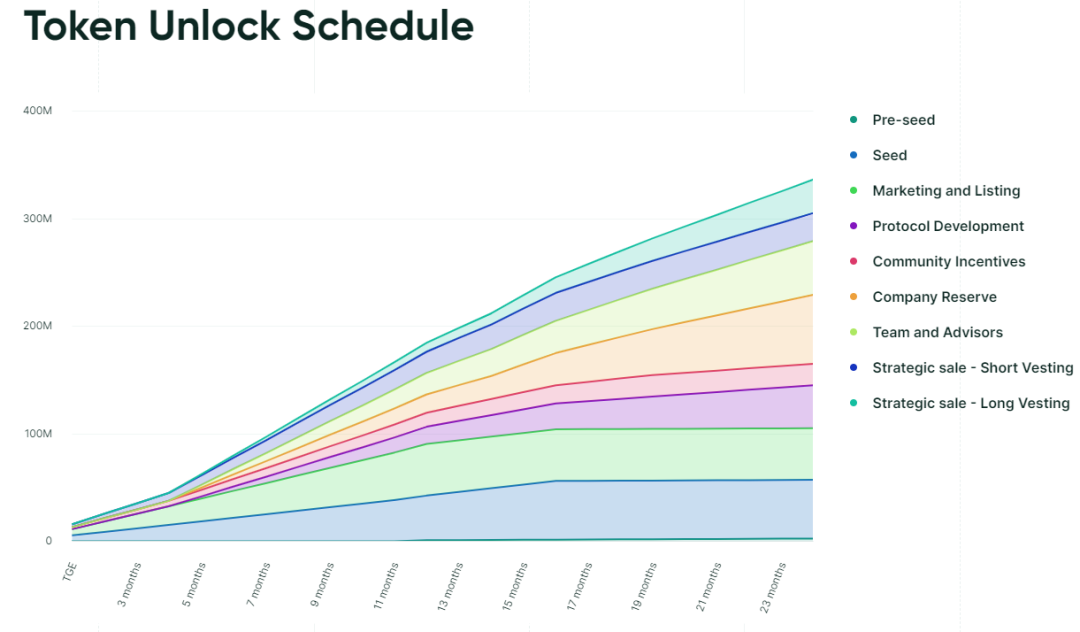
ML token holder address analysis:
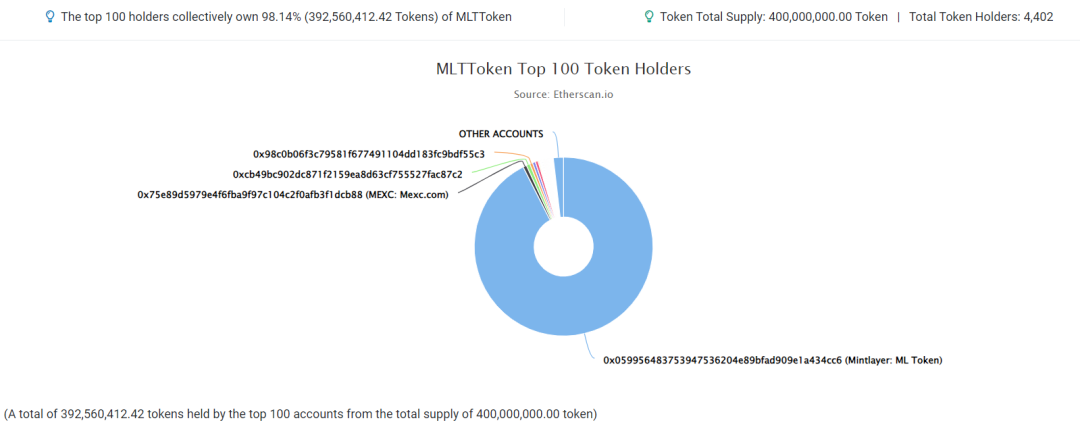
According to Etherscan data, as of September 11, 2023, there are 4402 current ML holder addresses, with the top 100 holders accounting for 98.14% and the top 10 holders accounting for 96.03%.
Among the top 10 addresses, 4 are contract/exchange/LP addresses, accounting for 94.13%. Excluding this portion, the top 100 addresses account for a total of 4.01%. It is evident that the current concentration of ML holder addresses is high, with tokens mainly concentrated in the hands of the team and liquidity providers.
Economic Model
1. Staking
The primary purpose of ML tokens is to pay transaction fees and additional costs associated with specific transactions (such as token creation transactions) and to allow users to stake and join the network as block producers through the consensus protocol.
Mintlayer's consensus protocol relies on pools to act as block producers in the network. The main benefit of doing so is that it allows an arbitrary number of users to be an active part of the network and receive rewards. When creating a pool, a minimum of 40,000 ML tokens must be used, which is exactly 0.01% of the initial total supply. Any user can stake to the pool to receive rewards later.
In the first 10 years of network operation, each block will have a block reward upon generation. The block reward is paid in $ML. The amount of reward received is proportional to the stake held by the pool, meaning that if the staked pool has 10% stake, it can expect to receive 10% of the block reward.
Block producers also collect transaction fees from the blocks they create, while network users can use any MLS-01 tokens (including ML) transferred on Mintlayer to pay fees.
2. Community Engagement
Mintlayer is an open-source project. To encourage community-driven protocols, $ML tokens allow their holders to express their views on the network's development. Users can help determine the development order of roadmap events, suggest features, and more.
3. Ecosystem Tools
ML tokens can be used to pay network fees and token issuance fees paid by users when issuing tokens on Mintlayer. RBB LAB's services can be purchased using ML tokens for:
- Mintlayer smart contract development
- Security audits of Mintlayer smart contracts
- Software engineering for decentralized applications on Mintlayer
IX. Advantages and Risks
Advantages
Mintlayer is a unique project that can act as a sidechain when isolated from its native functionality, as it has its own independent blockchain, PoS consensus, checkpoint system, and the ability to peg native BTC to wrapped Bitcoin equivalents using its MLS-01 or MLS-02 token standards. As Mintlayer inherits L2 functionality due to its integration with the Lightning Network, users can also benefit from off-chain transaction efficiency using BTC, ML, or MLS-01 tokens.
Mintlayer allows participants to achieve more use cases with BTC without relying on centralized exchanges. By leveraging the world's largest encrypted security and integrating the Lightning Network, Mintlayer can provide a platform for developers to build applications with real-world financial use cases.
Risks
Firstly, projects related to Bitcoin Layer2 and sidechains are gradually gaining momentum. Apart from MintLayer, there are some early projects such as RSK, Stacks, Liquid Network, etc. It remains to be seen whether MintLayer can stand out among these competitors.
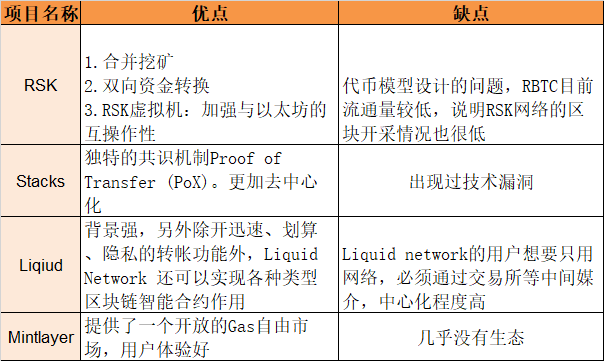
Secondly, the current scale of the Bitcoin ecosystem still lags behind Ethereum, both in terms of well-known projects and user base. The Bitcoin Layer2 ecosystem is still in the construction stage and needs market validation.
In conclusion, as Bitcoin scaling solutions continue to develop and more people explore the Bitcoin ecosystem and expand blockchain functionality, Mintlayer is worth continuous attention.
References
https://docs.mintlayer.org/
免责声明:本文章仅代表作者个人观点,不代表本平台的立场和观点。本文章仅供信息分享,不构成对任何人的任何投资建议。用户与作者之间的任何争议,与本平台无关。如网页中刊载的文章或图片涉及侵权,请提供相关的权利证明和身份证明发送邮件到support@aicoin.com,本平台相关工作人员将会进行核查。




